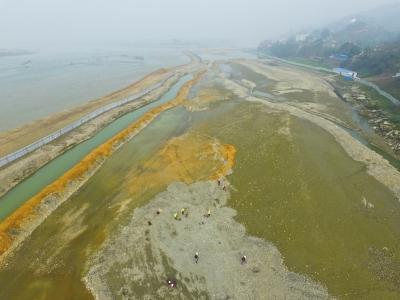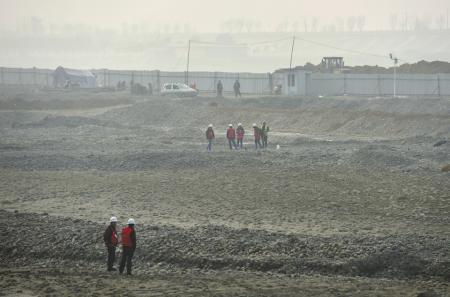In Sichuan province, Zhang Xianzhong shipwreck buried gold and silver where the water has been drained, metal detector out of static and dynamic | Immersion Silver | excavations | archaeology _ news

>
On January 5, Meishan city, Peng Jiang Kou Zhen a 1.2 km long in the minjiang River in mountain area in the blue wall, pebbles of river bottom exposed, several archaeologists with a metal detector trying to ascertain the distribution of cultural relics under the stone.
Zhang Xianzhong sink treasure site, after more than a month after the cofferdam, the water has been drained, jiangkou Immersion Silver archaeological excavation of the site was officially launched. This location the first time underwater archaeology, archaeological equipment technology is second to none.
The next 3 months, archaeologists in the archaeological excavation in the protected area of more than 2000 square meters. "Metal detectors already have action! "Archaeological sites, archaeological experts said Li Fei, the instructions will be found in the region. The archaeological excavations, first through a metal detector to determine key tap into regional, in the process of exploring, using total station precise positioning coordinates water cultural relics, using three dimensional imaging and aerial technology heritage information.
WCC-cover journalists Mao Yuting Zhang Lei Bo Liang Li Qing photography
Pumping
Continuous pumping a month out of 2000 square meters, "the island"
Since 2013, jiangkou Immersion Silver point repeated thefts of cultural relics. To prevent the recurrence of such a situation, the Sichuan Provincial Bureau of cultural relics and Archaeology Research Institute, the State administration of cultural heritage protection of the underwater cultural heritage centre and Peng mountain tube together, carried out excavations to protect.
Want to figure out the sunken ship where, according to historical records, combined with treasure locations that appear on several occasions, in pengshan Eguchi has drawn us a general location.
Sites under water, this is a difficult problem for archaeological, in Sichuan, and haven't had this kind of experience. So, again and again launched feasibility study meeting.
Cofferdam draining River, in dry areas to exploration and mining on, eventually becoming a consensus among members. Provincial Archaeological Institute's Director, said Gao Dalun, archaeological excavations of the cofferdam are relatively rare in China, and pengshan section every year from November to next March as the waters of the minjiang River in dry season, is the archaeological excavation of a good time.
1 months ago, after walls put up, 10 high power pump start at the same time, more than 2000 square meters of water in the region was finally drained, revealing a pebble, forming a "River Island".

>
Align= "Center" > January 5, jiangkou Immersion Silver archaeological dig, explore several archaeologists with a metal detector.
Detection
Treasures hidden in the 2 m following a major high-tech equipment to battle
Despite pumping "decadent", archaeological excavations in the next 3 months, seeping groundwater will from time to time, pumping will be the norm.
"Pumping the water, and underwater archaeology. "Said Liu zhiyan, head of the site, if there are treasures hidden in the depths of 2 to 3 meters.
"For us, it was a challenge. "Provincial Archaeological Institute experts said Li Fei, pebbles and sand mix, compared with mining in the pit, piling up more vertical structure less stable, more trouble to explore.
The spelling of archaeology as well as equipment. Fluorescence analyzers, endoscopy and other high-tech stage, by introducing new devices, detecting wood composition, moisture content and so on, are not a problem.
Archaeological sites, several staff members were using metal detectors to detect. Li Fei said: "before detection using metal detectors, have been found. "But how big, plum declined.
"Archaeology is not a treasure hunt. "Said Liu zhiyan, the important is to determine the distribution of cultural relics, archaeological excavation buried," Zhang Xianzhong was clearly not historical mysteries by ambushes, immersion silver, is the most important. ”
Li Fei said the archaeological, Sichuan archaeology can be said to be of high scientific and technological content. First, through archaeological excavation projects of temporary cofferdam platform, the other is through a metal detector to determine focus on exploring regional, three are in the excavation water heritage using total station in precise positioning coordinates, using three dimensional imaging and aerial technology heritage information. "Total station position, layman's terms, is discovered when, in the form of detailed coordinates, mark the relics. "Plum says," in this way, all archaeological finds are the exact location of their associated relations clearly, very helpful for us to restore. ”
Support
Leading experts into the war would draw Optima archaeology ideas and experience
Participation in jiangkou Immersion Silver archaeological project, also from the State Bureau of cultural relics expert Zhou Chun water underwater cultural heritage protection Center, the fellow from Nanchong Pengan, graduated from the history Department of Xiamen University archaeology profession, are the leading experts in underwater archaeology techniques.
In 2015, the Liaoning chaired by Zhou Chunshui "Dandong first" wreck of the Qing dynasty (addressed to Optima) archaeological project, awarded 2015 top ten archaeological discoveries in China.
"Estuary this project, much less difficult than by Optima. In practice, it will draw experience from the Optima project ideas and experience, because this is actually a shipwreck. "Zhou Chunshui says," with excavation depth may be unearthed silk, wood, leather and other organic matter, is also developing the appropriate water-protection measures. ”
Zhou Chunshui says time is 3 months of the current excavations, as water levels rise, will end the excavations.
View
Director of the National Museum of Archaeology: or a sunken ship, the site Immersion Silver
"Shi Niu Shi gu, silver should never five. Someone to read through, buy as much house in Chengdu. ”
Historically, there was Zhang Xianzhong "thousand-ship Silver" Eguchi says, said Zhang Xianzhong treasures of thousands of ships, sunk in the river bottom, leaving a hidden mystery.
BA-Shu culture expert, author of the theory of Zhang Xianzhong Yuan Tingdong opposing views on this. ": After reading Zhang Xianzhong are bandits there, a large group of people, fighting everywhere, all for money. How is it possible to hide military supplies? "Yuan Tingdong said, jiangkou Immersion Silver, jiangkou wrecks may be more appropriate.
Yuan Tingdong, folklore should be respected, since called Eguchi Immersion Silver, that will not change. But universal common sense to the people: "not Zhang Xianzhong active hid the treasure in pengshan, but war defeat here, scattered. ”
Yang Lin, Director of National Museum of archaeology, also identify with the wreck says. "We see here, also as a shipwreck. "Yang said, though after more than 300 years, but under the water, the hull does not decay, save a real possibility. "There are no weapons, the ship's unearthed in things like wood, so Zhang Xianzhong was ambushed in pengshan Eguchi, also need time to wait. Will answer in kind. ”
The scene would
Into the core to have five gates
On January 5, the WCC-cover journalists, came to the archaeological site is located in pengshan in jiangkou across the Government. Paid employment visas, successfully entered the first door. "The only card, not the person, which call did not have to. "The security officer said.
Archaeological sites at a glance, but want to enter the site, also 4 door. Through the locker room, tool room, screening room, the reporters came to the final door, three special police guard a security channel, next to a fingerprint.
Card doesn't work here, only the input fingerprint personnel, able to access the last door. "This is the last door, mainly made of metal detection, prevent people take things out. "The security officer said, around the cofferdam as a whole, not only there are many monitoring, there are a lot of police, on duty for 24 hours.
News
Expert team debut
Liu zhiyan
Male, born in 1981, people in Jilin city, research associate, archaeology team leader. Sichuan Institute of historic relic archaeology underwater archaeology Center Director, Director of the Center for public archaeology. 2004 graduated from the history Department of Xiamen University archaeology major, received a Bachelor's degree. 2007 graduated from heritage and Museology Department of Fudan University, received a master's degree. In 2007, serving Sichuan Institute of historic relic archaeology.
Main directions for the Southwest archaeology, underwater archaeology and archaeology to the public. Hosted in Pingshan County of ruins and Sapa dozens of archaeological projects, such as the cemetery excavations, which pengshanzhenghua of Pingshan County, village cemetery in the Song dynasty, called yan and Luo Gou sites are rated as important archaeological discoveries in China.
Spring weeks
Male, born in January 1973 in pengan County of Sichuan people in July 1995, graduated from the Department of history, Archaeology Department of Xiamen University, a Bachelor, Associate Research Librarian. Currently employed in State administration of cultural heritage protection of the underwater cultural heritage Center. Work concerning the field of underwater archaeology and the protection of the underwater cultural heritage, focusing on marine culture, archaeology and ancient shipwrecks maritime history, South-Eastern ceramic trade, underwater archaeology technical direction, with helium nitrogen oxygen diving 60-meter, boat dives 3 qualification.
Since 2004, China in the third period after training in underwater archaeology, participated in over the years almost all the national underwater archaeological projects. Guangdong Nanao, first shipwreck excavations first shipwreck investigations and Hubei, Liaoning Dandong city surveys.
Personal management of archaeological projects in 2012, "South Australia first" Ming dynasty shipwrecks underwater archaeology project won the third prize in the field. Liaoning "Dandong first" wreck of the Qing dynasty (addressed to Optima) awarded 2015 China's top ten archaeological discoveries, 2015, Cass County archaeological discoveries.
Li Fei
2011 Museum of archaeology, Peking University graduate, now the Sichuan Institute of historic relic archaeology librarian. Main research interests include the Han and Tang dynasties archaeology. Participated in da Bao Zi Shan, Li Guangyuan, ruins, tank song Tomb, anyue Pilu Temple ruins excavation projects and Cliff tombs, such as surveys and other projects. In recent years participated in the ancient tubo, salt road, Lai Chi Kok Road and other cultural route surveys.
Xin Guangcan
Female, born in 1983, master of Beijing University Department of archaeology School of archaeology, Singapore National University PhD in Southeast Asian studies, specializes in Song Yuanming archaeology and archaeological ceramics. Currently employed in State administration of cultural heritage protection of the underwater cultural heritage Center. Participated in Fufeng County, Shaanxi Province Zhou Yuan bronze Lee site excavation and consolidation, Southern Song dynasty official kilns in Longquan, Zhejiang Province, XI Kou village site excavation, Singapore Fort Canning Hill spice garden area excavation and documentation work.
> Editor: Li Peng
Article keywords:Immersion Silver mining archaeology
I want feedback
Save a Web page
Sichuan online-huaxi City newspaper
四川省张献忠沉船埋藏金银的地方水被抽干,金属探测仪探出动静|沉银|发掘|考古_新闻资讯

>
1月5日,眉山市彭山区江口镇岷江河道内一道长1.2公里的蓝色围挡里,江底的鹅卵石露出,几位考古人员拿着金属探测仪试图摸清石头下的文物分布。
张献忠沉宝遗址,历经一个月的围堰后,水已经被抽干,江口沉银遗址考古发掘正式启动。这也是川内首次水下考古,使用的考古设备科技含量首屈一指。
接下来的3个月里,考古人员将在2000多平方米的保护区里进行考古挖掘。“金属探测仪已经有动静了!”在考古现场,考古专家李飞说,这说明在该区域将有所发现。此次考古发掘,首先通过金属探测仪确定重点发掘区域,在发掘过程中,将采用全站仪精确定位出水文物坐标,同时利用三维成像和航拍技术采集文物信息。
华西都市报—封面新闻记者毛玉婷梁波李庆摄影张磊
抽水
连续抽水一个月 露出2000平方米“小岛”
自2013年以来,江口沉银点文物屡遭盗窃。为防止再次出现这样的局面,四川省文物考古研究院、国家文物局水下文化遗产保护中心和彭山区文管所联合起来,共同开展发掘保护。
想要弄清沉船具体地点,得按照史书上的记载,再结合数次宝物出现的地点,在彭山江口划出一个大概位置。
遗址在水下,这对考古是一道难题,在川内,还没有过这样的经验。于是,一次次的论证会发起。
围堰抽干江水,在干燥区域上进行探方挖掘,最终成为大家的共识。省考古院院长高大伦称,围堰考古发掘的方式在中国都比较少见,而岷江水域彭山区段每年11月至次年3月为枯水期,正是考古挖掘的好时机。
1个月前,围挡搭好后,10台高功率抽水机同时启动,2000多平方米区域内的水终于抽干了,露出一颗颗鹅卵石,形成了一个“江中小岛”。

>
align="center"> 1月5日,江口沉银考古发掘现场,几位考古人员拿着金属探测仪进行探测。
探测
宝物藏在2米以下 一大拨高科技设备上阵
尽管抽水抽得“昏天黑地”,接下来的3个月考古发掘里,地下水仍会不时渗出,抽水将成为常态。
“抽了水,还是水下考古。”遗址现场负责人刘志岩说,如果有宝物,应该藏在2至3米深处。
“对我们来说,是个挑战。”省考古院专家李飞说,鹅卵石和沙土混合,与土坑里的挖掘相比,堆积物更散,竖直结构更不稳定,发掘起来更费事。
此次考古拼的还有设备。荧光分析仪、内窥镜等高科技登场,通过新引入的设备,探测木材成分、含水量等,都不是问题了。
遗址现场,几个工作人员正在使用金属探测仪探测。李飞说:“之前用金属探测仪进行探测,已经有所发现。”但动静有多大,李飞不愿透露。
“考古不是寻宝。”刘志岩说,此次考古发掘重要在于确定文物分布范围、埋藏的相关情况,“搞清楚张献忠是不是被伏击、沉银历史谜团,才是最重要的。”
李飞说,此次考古,可以说是四川考古界科技含量最高的一次。一是通过临时围堰工程解决考古发掘平台,二是通过金属探测仪确定重点发掘区域,三是在发掘过程中采用全站仪精确定位出水文物坐标,同时利用三维成像和航拍技术采集文物信息。“全站仪定位,通俗地说,就是在发现文物后,以详细坐标的形式,把这个文物标出来。”李飞说,“这样一来,所有出土文物都有确切位置,其伴生关系清清楚楚,对于我们还原历史很有帮助。”
助阵
顶尖专家参战 将借鉴致远舰考古经验
参与江口沉银考古项目的,还有来自国家文物局水下文化遗产保护中心的专家周春水,这位来自四川南充蓬安的老乡,毕业于厦门大学历史系考古学专业,是水下考古技术的顶尖专家。
2015年,周春水主持的辽宁“丹东一号”清代沉船(致远舰)考古项目,获评2015年度中国十大考古新发现。
“江口这个项目,难度要比致远舰小得多。实际工作中,也会借鉴致远舰项目经验,因为这实际上也是个沉船遗址。”周春水说,“随着发掘深入,可能会出土丝绸、木板、皮革等有机物,目前也制订了相应的出水保护措施。”
周春水说,目前考古发掘的时间是3个月,随着水位上涨,将会结束发掘工作。
观点
国家博物馆考古部主任:沉银遗址或也是沉船遗址
“石牛对石鼓,银子万万五。有人识得破,买尽成都府。”
历史上,曾有张献忠“千船沉银”江口之说,称张献忠把千船的宝物,沉在江底,留下了定藏之谜。
巴蜀文化专家、《张献忠论传》作者袁庭栋对此持反对意见。“张献忠是流寇,养一大帮人,到处打仗,一路都要钱。怎么可能把军资藏起来?”袁庭栋说,江口沉银,叫江口沉船可能更合适一点。
在袁庭栋看来,应该尊重民俗,既然都叫江口沉银,那就不好改了。但是要向民众普及一个常识:“不是张献忠主动把宝物藏在彭山,而是在这儿打仗兵败,散落在此。”
国家博物馆考古部主任杨林,也比较认同沉船一说。“我们把这里,也当成沉船遗址。”杨林说,虽然历经300多年,但因为在水下,船身不会腐烂,保存的可能性极大。“目前还没有兵器、船上的木头之类的东西出土,所以张献忠是否在彭山江口遭到伏击,还需要时间等待。实物会给出答案。”
现场目击
想进核心区要过五道门
1月5日,华西都市报-封面新闻记者,来到位于彭山区江口镇政府对面的考古现场。领到工作证后,成功进入第一扇门。“只看证,不看人,哪个打电话都没得用。”安保人员说。
考古现场一览无余,但想要进入遗址内,还得过4道门。通过更衣室、工具室、安检室,记者来到最后一道门,三名特警守着一个安检通道,旁边摆着一个指纹打卡机。
工作证在这里不管用了,只有录入指纹的人员,才能进出这最后一道门。“这是最后一道门,主要做金属探测,防止有人把东西带出来。”安保人员说,整个围堰周围,不仅有众多监控,更有数量不菲的特警,24小时执勤。
新闻人物
专家团队亮相
◎刘志岩
男,1981年生,吉林市人,副研究员,考古领队。四川省文物考古研究院水下考古中心主任、公众考古中心主任。2004年毕业于厦门大学历史系考古专业,获学士学位。2007年毕业于复旦大学文物与博物馆学系,获硕士学位。2007年起,任职四川省文物考古研究院。
主要工作方向为西南地区考古、水下考古和公众考古。主持过屏山县叫化岩遗址和沙坝墓地等数十个考古项目的发掘,其中彭山正华村宋代墓地、屏山县叫化岩和骆家沟遗址等被评为中国考古重要发现。
◎周春水
男,1973年1月生,四川蓬安县人,1995年7月毕业于厦门大学历史系考古学专业,获学士学位,副研究馆员。现任职于国家文物局水下文化遗产保护中心。工作内容涉及水下考古、水下文化遗产保护领域,侧重于海洋文化、古代沉船考古与航海史迹、东南陶瓷贸易、水下考古技术等方向,具备氦氮氧深潜60米、船潜3的资质。
自2004年第三期中国水下考古培训后,几乎参与了历年来所有的国家水下考古项目。如广东南澳一号沉船发掘、辽宁丹东一号沉船调查和湖北均州古城调查等。
个人主持过的考古项目,2012年“南澳一号”明代沉船水下考古项目获评田野考古三等奖。辽宁“丹东一号”清代沉船(致远舰)获评2015年度中国十大考古新发现、中国社会科学院2015年中国考古新发现。
◎李飞
2011年北京大学考古文博学院研究生毕业,现为四川省文物考古研究院馆员。主要研究方向为汉唐考古。曾参加礼县大堡子山遗址、广元水柜村宋墓、安岳毗卢寺遗址等发掘项目及乐山崖墓调查等项目。近年来多次参加唐蕃古道、盐业古道、荔枝古道等文化线路调查。
◎辛光灿
女,1983年生,北京大学考古文博学院考古学硕士,新加坡国立大学东南亚研究学博士,专业领域为宋元明考古和陶瓷考古。现任职于国家文物局水下文化遗产保护中心。参与过陕西扶风县周原李家铸铜遗址发掘与整理、浙江省龙泉溪口村南宋官窑遗址发掘、新加坡福康宁山香料园区域发掘与资料整理等工作。
>责任编辑:李鹏
文章关键词: 沉银 发掘 考古
我要反馈
保存网页
四川在线-华西都市报